A Numerical Study of the Temperature Reduction by Water Spray Systems within Urban Street Canyons
Abstract
:1. Introduction
2. Methods
2.1. Computational Geometry and Grids
2.2. Numerical Scheme
2.3. Boundary Conditions
2.4. Water Spray Nozzle and Droplet Characteristics
2.5. Cooling Effect Simulation Cases
3. Model Validation
3.1. Validation of the Flow Field in Urban Street Canyon
3.2. Evaporation Cooling Validation
4. Results and Discussion
4.1. Cooling Effect with Different Aspect Ratio and Relative Humidity
4.2. Effects of Water Droplet Size and Height of Spray Nozzles
5. Conclusions
- (1)
- Under region I, the cooling effects were about the same (with a difference of around 1 °C) for different aspect ratios. For region II, H/W = 3 had the best cooling performance, H/W = 1 was the second, and H/W was the third.
- (2)
- Relative humidity has significant influence on the cooling performance. The drier the air, the better the cooling performance of the water spray system is.
- (3)
- The cooling effect was better when spraying large water droplets into the air than small ones. This was due to the larger velocity and water mass flow rate caused by the large water droplets.
- (4)
- Increasing the nozzle height (from 2.5 to 3.5 m) would not increase the cooling effect at the height of 1.5 m.
Acknowledgments
Author Contributions
Conflicts of Interest
Appendix A. Governing Equations of the Continuous Phase
Appendix B. Governing Equations of the Discrete Phase (Water Droplets)
Appendix C. Wet Bulb Temperature
References
- Sarrat, C.; Lemonsu, A.; Masson, V.; Guedalia, D. Impact of urban heat island on regional atmospheric pollution. Atmos. Environ. 2006, 40, 1743–1758. [Google Scholar] [CrossRef]
- Kovats, R.S.; Hajat, S. Heat stress and public health: A critical review. Ann. Rev. Public Health 2008, 29, 41–55. [Google Scholar] [CrossRef] [PubMed]
- Isaac, M.; Van Vuuren, D.P. Modeling global residential sector energy demand for heating and air conditioning in the context of climate change. Energy Policy 2009, 37, 507–521. [Google Scholar] [CrossRef]
- Alexandri, E.; Jones, P. Temperature decreases in an urban canyon due to green walls and green roofs in diverse climates. Build. Environ. 2008, 43, 480–493. [Google Scholar] [CrossRef]
- Runsheng, T.; Etzion, Y.; Erell, E. Experimental studies on a novel roof pond configuration for the cooling of buildings. Renew. Energy 2003, 28, 1513–1522. [Google Scholar] [CrossRef]
- Montazeri, H.; Blocken, B.; Hensen, J.L.M. Evaporative cooling by water spray systems: CFD simulation, experimental validation and sensitivity analysis. Build. Environ. 2015, 83, 129–141. [Google Scholar] [CrossRef]
- Montazeri, H.; Toparlar, Y.; Blocken, B.; Hensen, J.L.M. Simulating the cooling effects of water spray systems in urban landscapes: A computational fluid dynamics study in Rotterdam, The Netherlands. Landsc. Urban Plan. 2017, 159, 85–100. [Google Scholar] [CrossRef]
- Jain, S.P.; Rao, K.R. Experimental study on the effect of roof spray cooling on unconditioned and conditioned buildings. Build. Sci. 1974, 9, 9–16. [Google Scholar] [CrossRef]
- Huang, C.; Ye, D.; Zhao, H.; Liang, T.; Lin, Z.; Yin, H.; Yang, Y. The research and application of spray cooling technology in Shanghai Expo. Appl. Therm. Eng. 2011, 31, 3726–3735. [Google Scholar] [CrossRef]
- Kang, D.; Strand, R.K. Modeling of simultaneous heat and mass transfer within passive down-draft evaporative cooling (PDEC) towers with spray in FLUENT. Energy Build. 2013, 62, 196–209. [Google Scholar] [CrossRef]
- Baik, J.J.; Kim, J.J. A numerical study of flow and pollutant dispersion characteristics in urban street canyons. J. Appl. Meteorol. 1999, 38, 1576–1589. [Google Scholar] [CrossRef]
- Chan, T.L.; Dong, G.; Leung, C.W.; Cheung, C.S.; Hung, W.T. Validation of a two-dimensional pollutant dispersion model in an isolated street canyon. Atmos. Environ. 2002, 36, 861–872. [Google Scholar] [CrossRef]
- ANSYS Inc. ANSYS Fluent 15.0 Theory Guide; ANSYS Inc.: Canonsburg, PA, USA, 2013. [Google Scholar]
- Launder, B.E.; Spalding, D.B. The numerical computation of turbulent flows. Comput. Methods Appl. Mech. Eng. 1974, 3, 269–289. [Google Scholar] [CrossRef]
- Rosin, P.; Rammler, E. The laws governing the fineness of powdered coal. J. Inst. of Fuel 1933, 31, 29–36. [Google Scholar]
- Baik, J.J.; Park, R.S.; Chun, H.Y.; Kim, J.J. A laboratory model of urban street-canyon flows. J. Appl. Meteorol. 2000, 39, 1592–1600. [Google Scholar] [CrossRef]
- Sureshkumar, R.; Kale, S.R.; Dhar, P.L. Heat and mass transfer processes between a water spray and ambient air—I. Experimental data. Appl. Therm. Eng. 2008, 28, 349–360. [Google Scholar] [CrossRef]
- Sureshkumar, R.; Kale, S.R.; Dhar, P.L. Heat and mass transfer processes between a water spray and ambient air—II Simulations. Appl. Therm. Eng. 2008, 28, 361–371. [Google Scholar] [CrossRef]
- Moureh, J.; Yataghene, M. Numerical and experimental study of airflow patterns and global exchanges through an air curtain subjected to external lateral flow. Exp. Therm. Fluid Sci. 2016, 74, 308–323. [Google Scholar] [CrossRef]
- Morsi, S.; Alexander, A.J. An investigation of particle trajectories in two-phase flow systems. J. Fluid Mech. 1972, 55, 193–208. [Google Scholar] [CrossRef]
- Ranz, W.E.; Marshall, W.R. Evaporation from drops. Chem. Eng. Prog 1952, 48, 141–146. [Google Scholar]
- Sazhin, S.S. Advanced models of fuel droplet heating and evaporation. Prog. Energy Combust. Sci. 2006, 32, 162–214. [Google Scholar] [CrossRef]
- Campbell, G.S.; Norman, J.M. An introduction to Environmental Biophysics; Springer Science & Business Media: New York, NY, USA, 1998; p. 44. [Google Scholar]
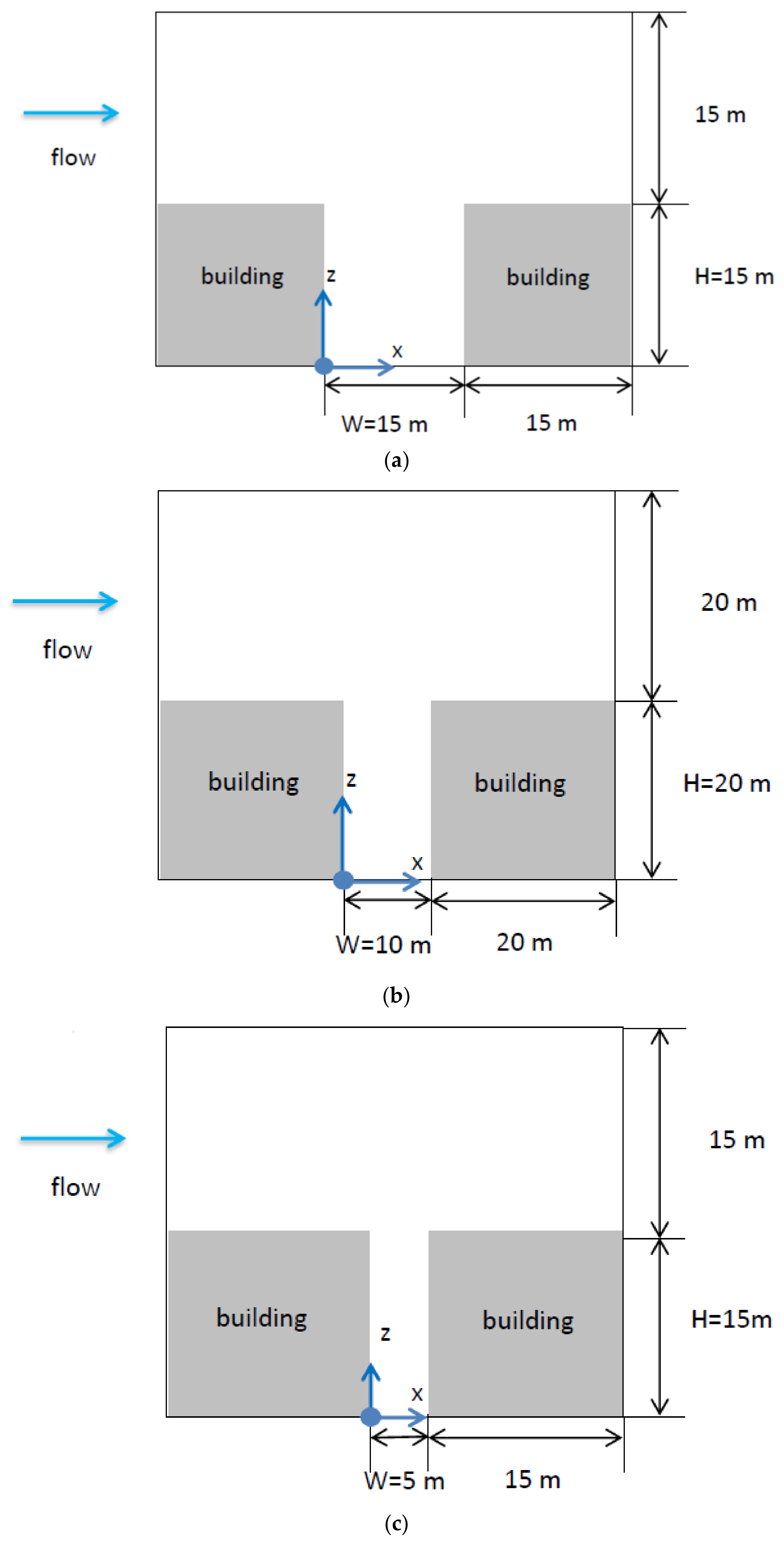
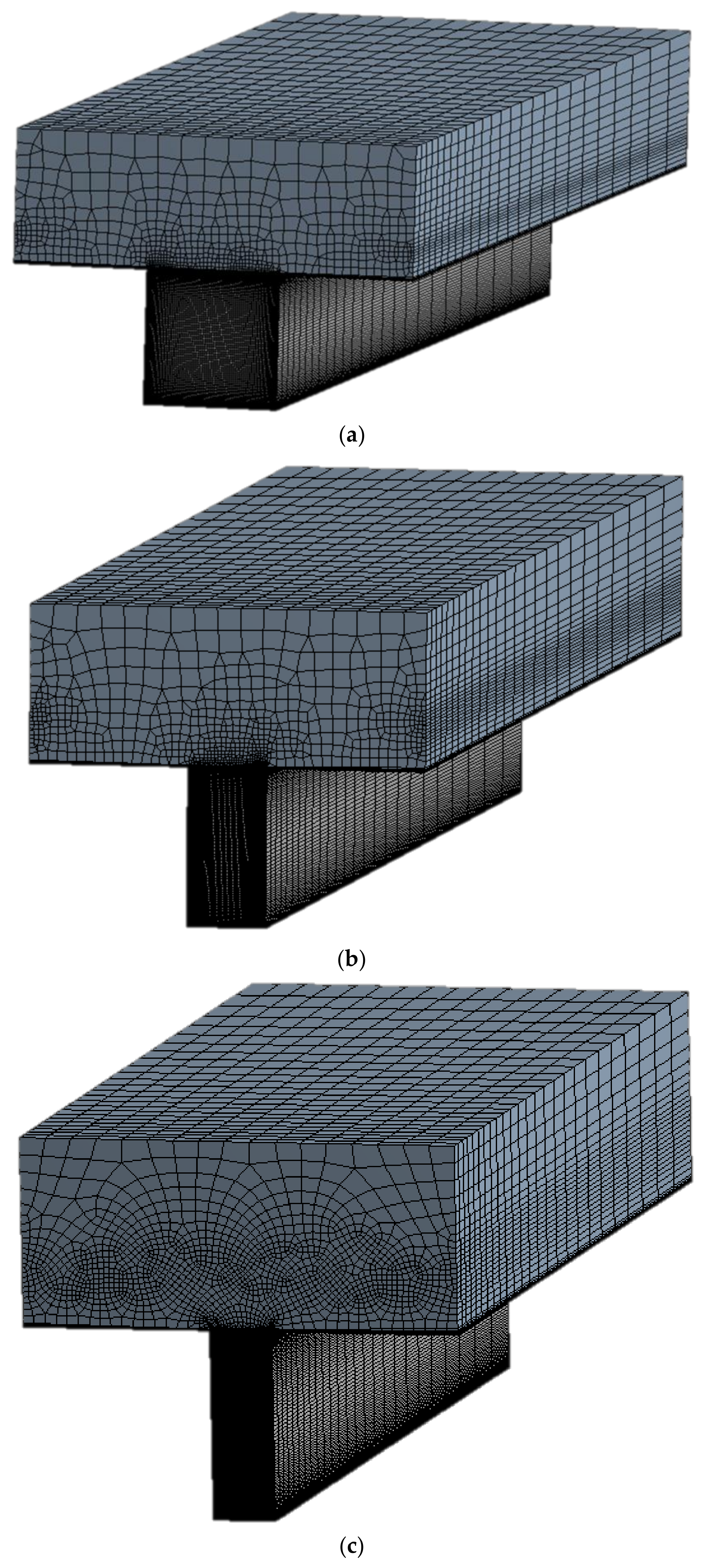


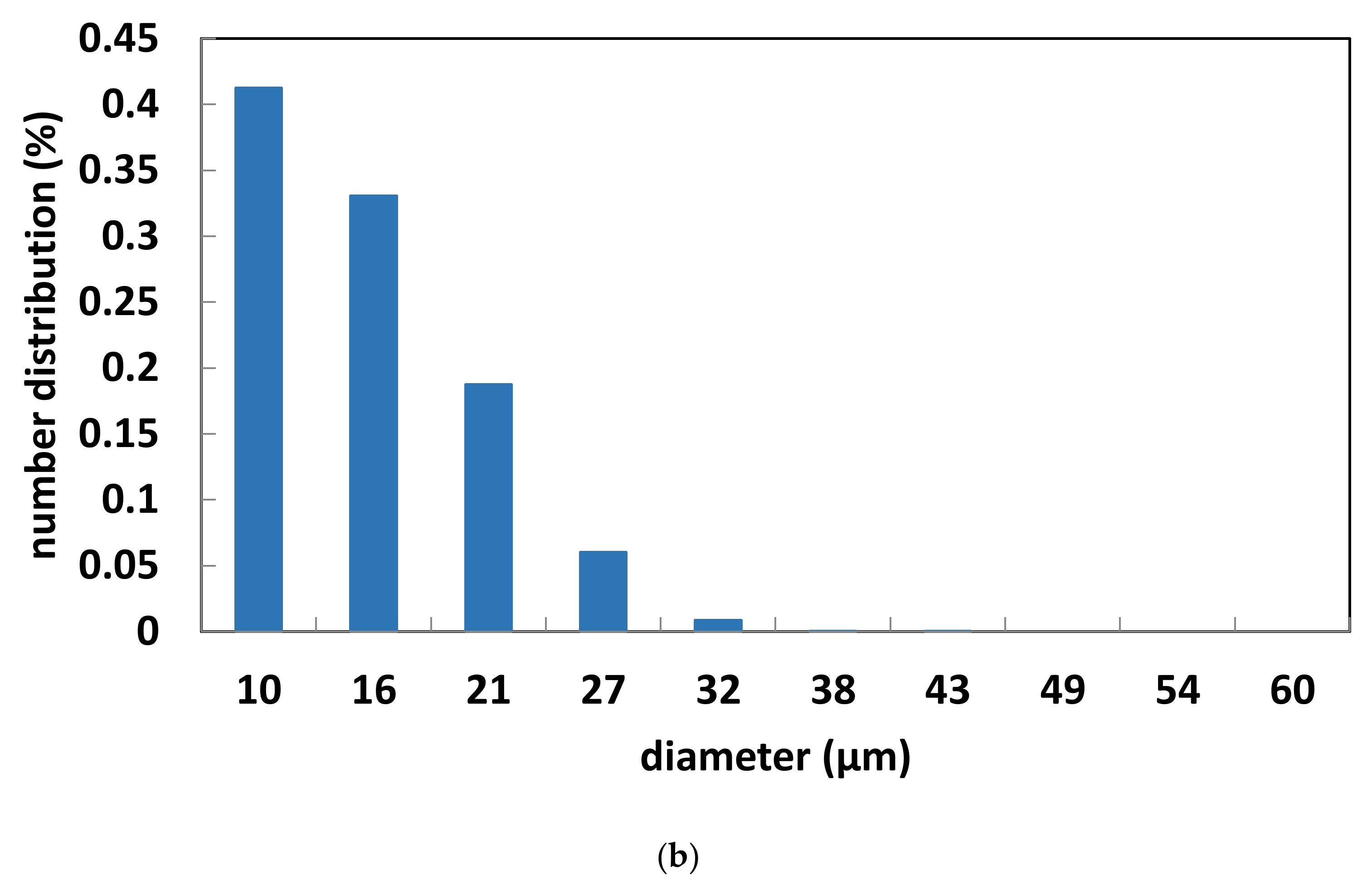
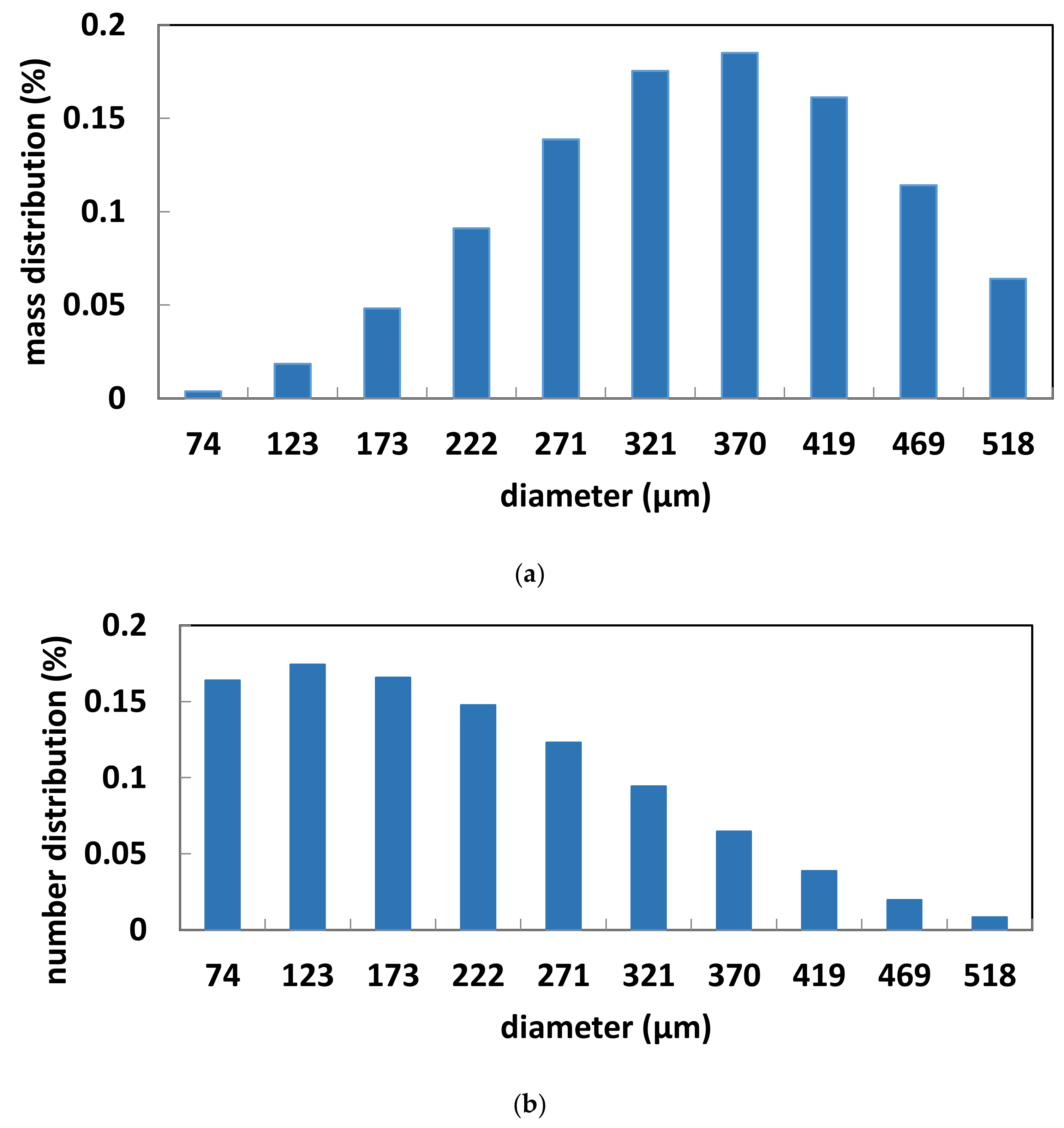
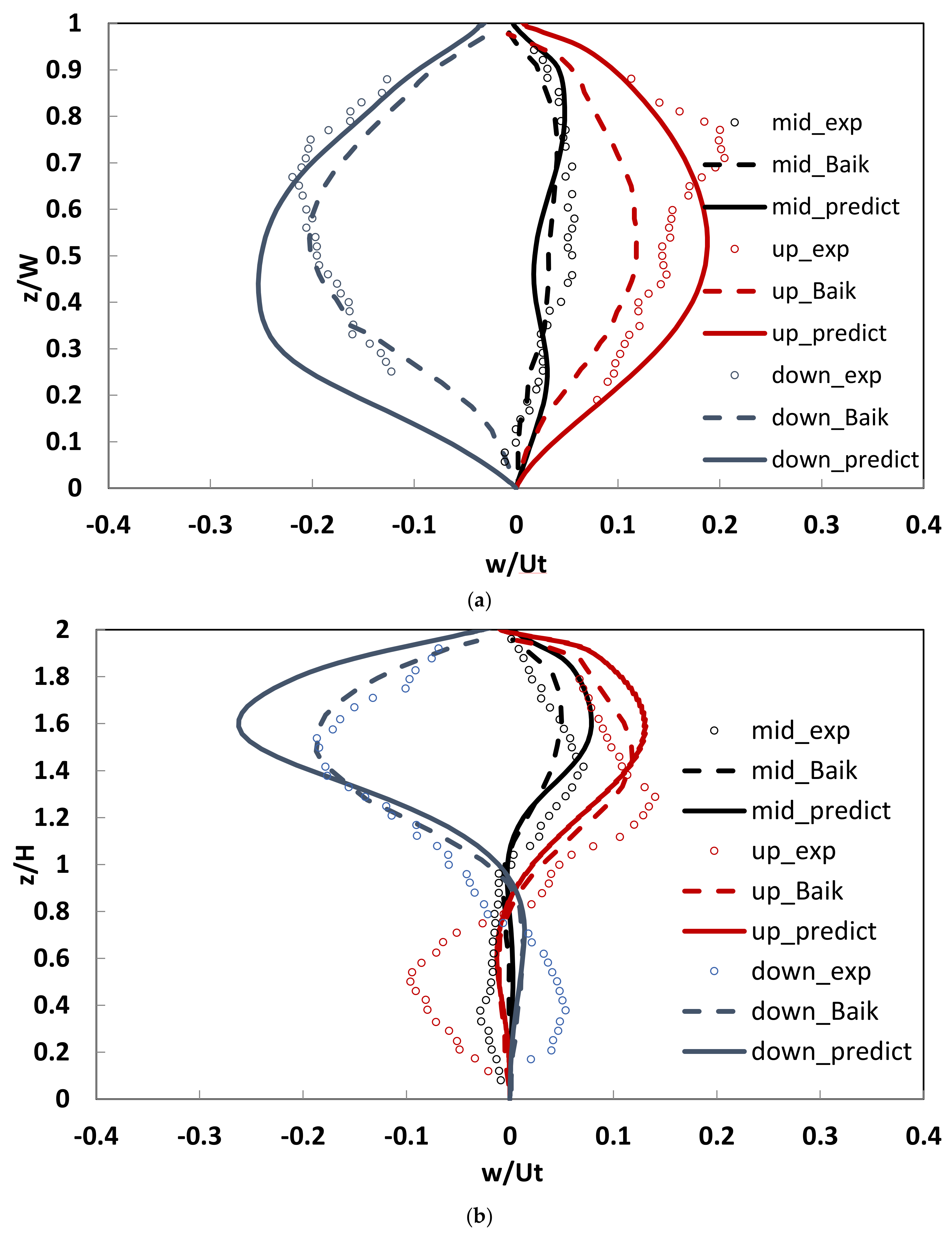



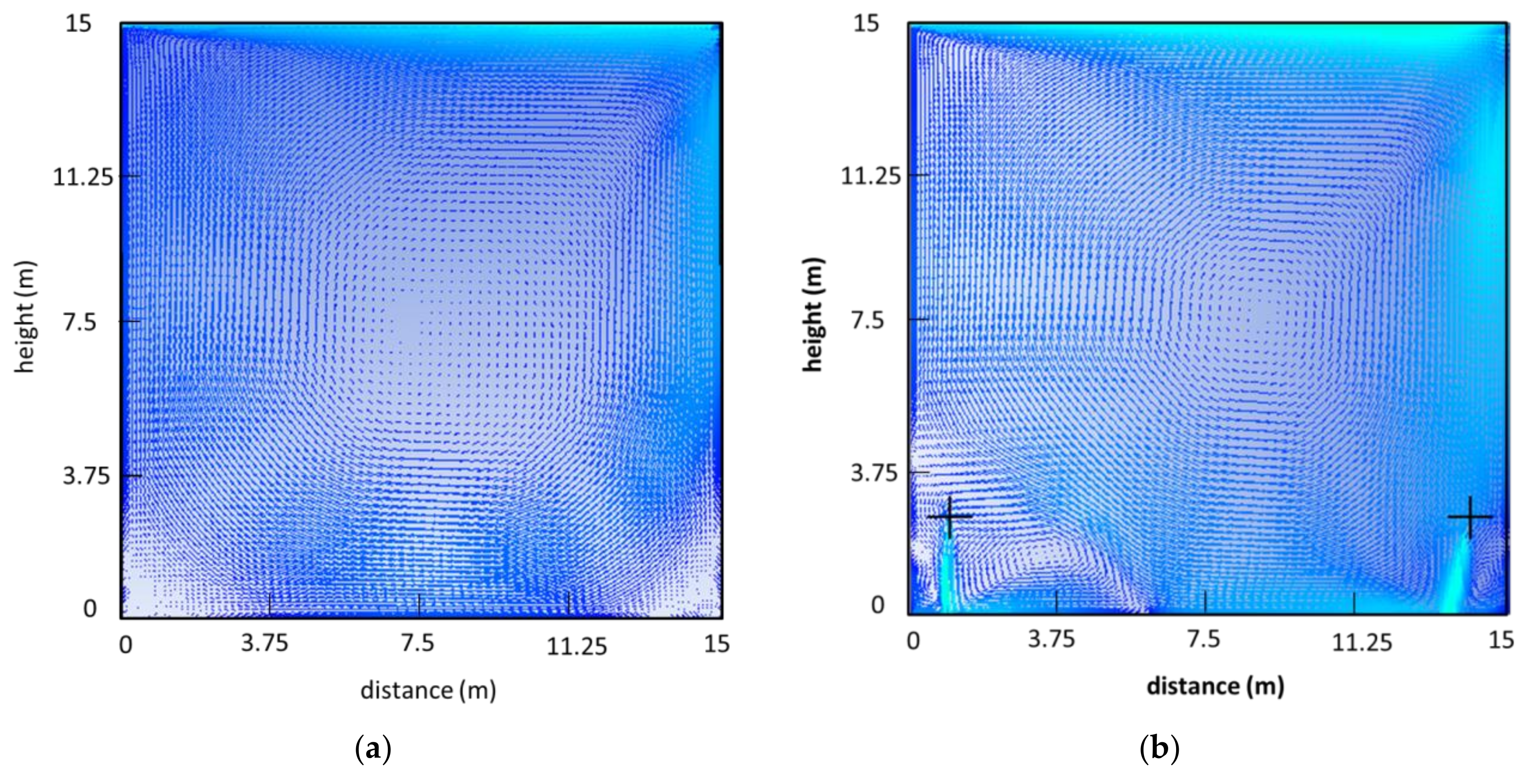
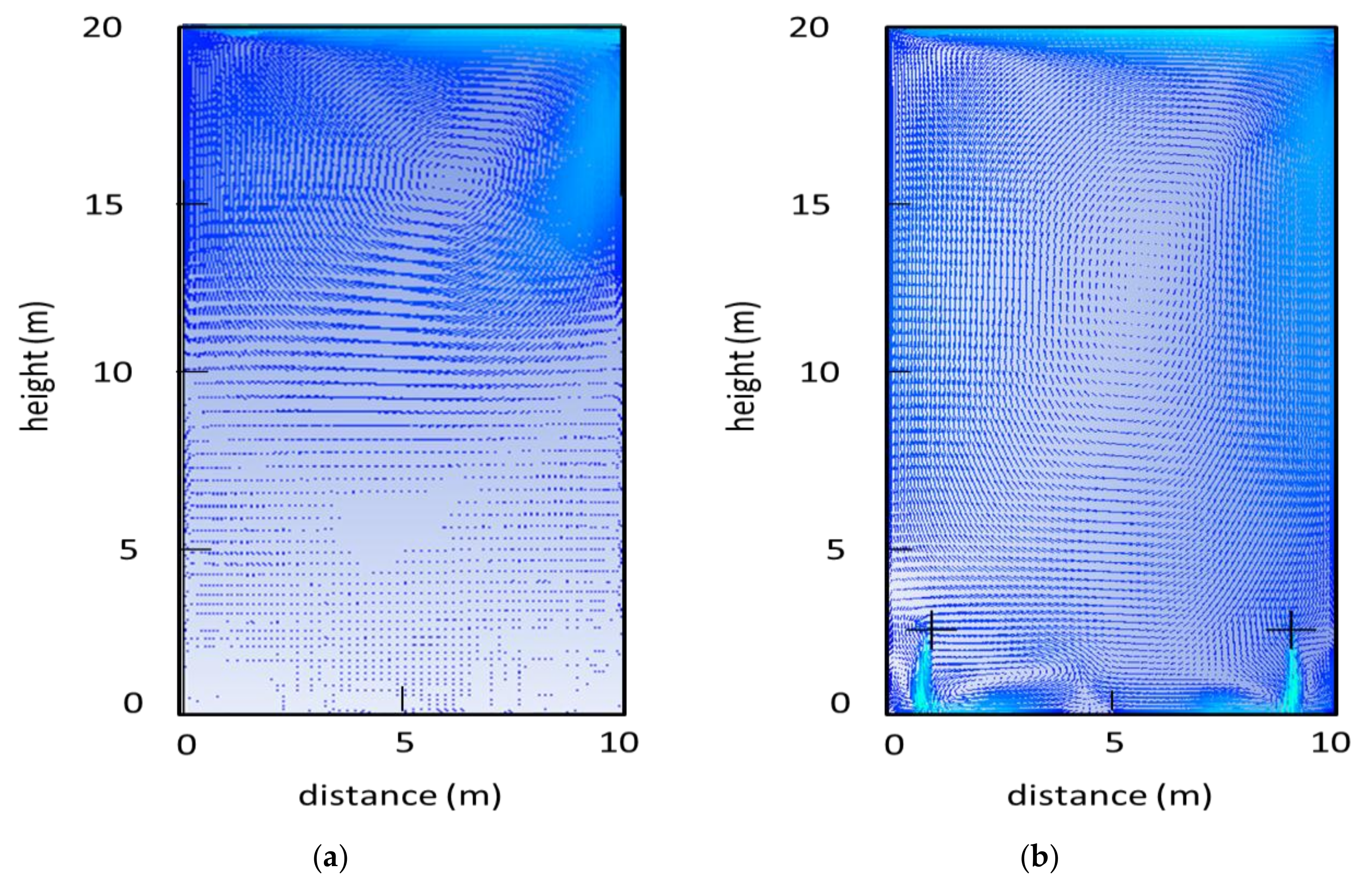
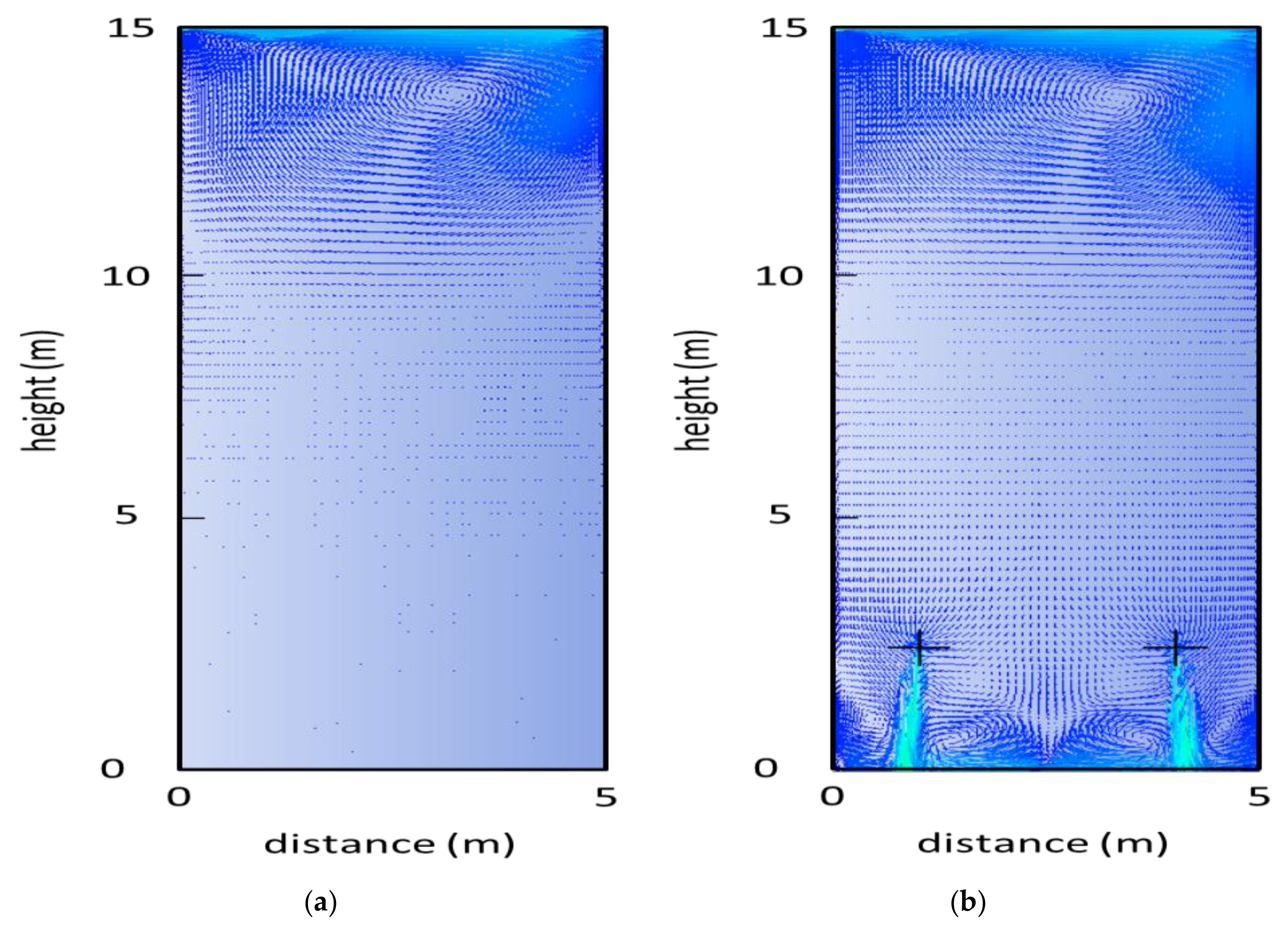



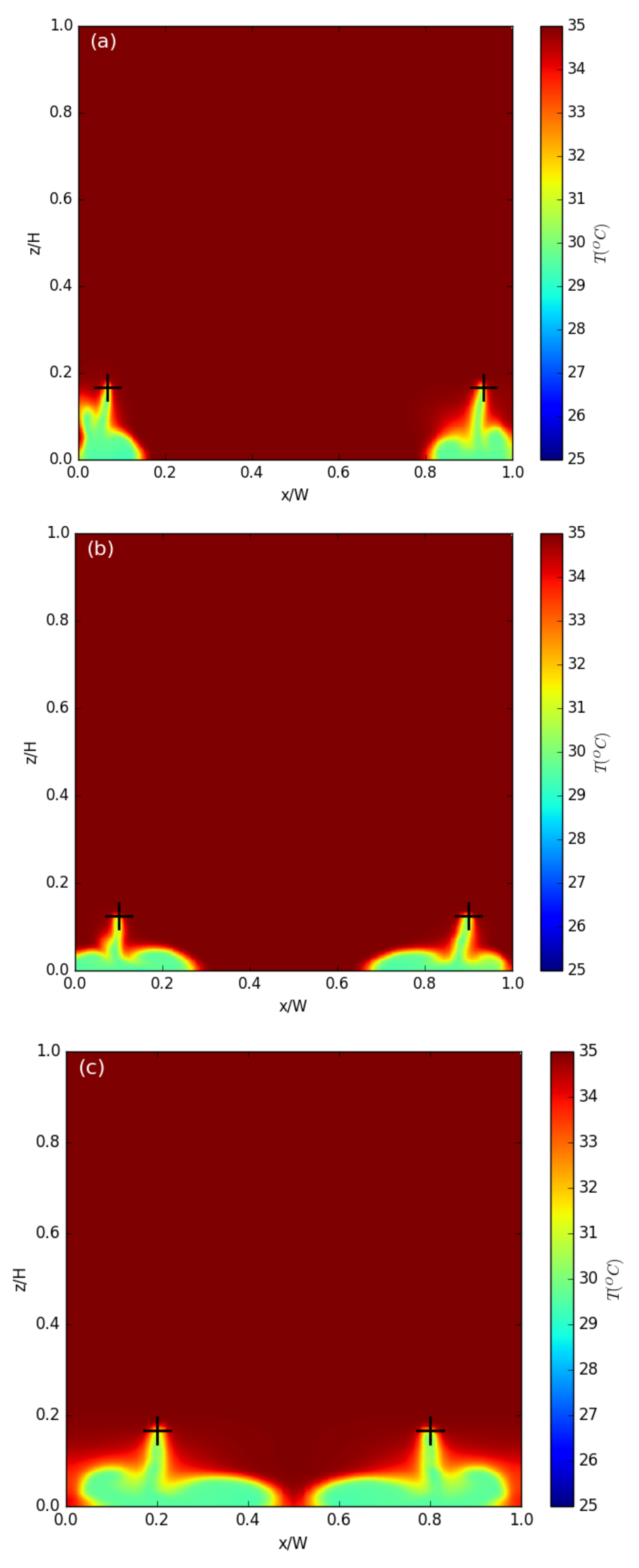
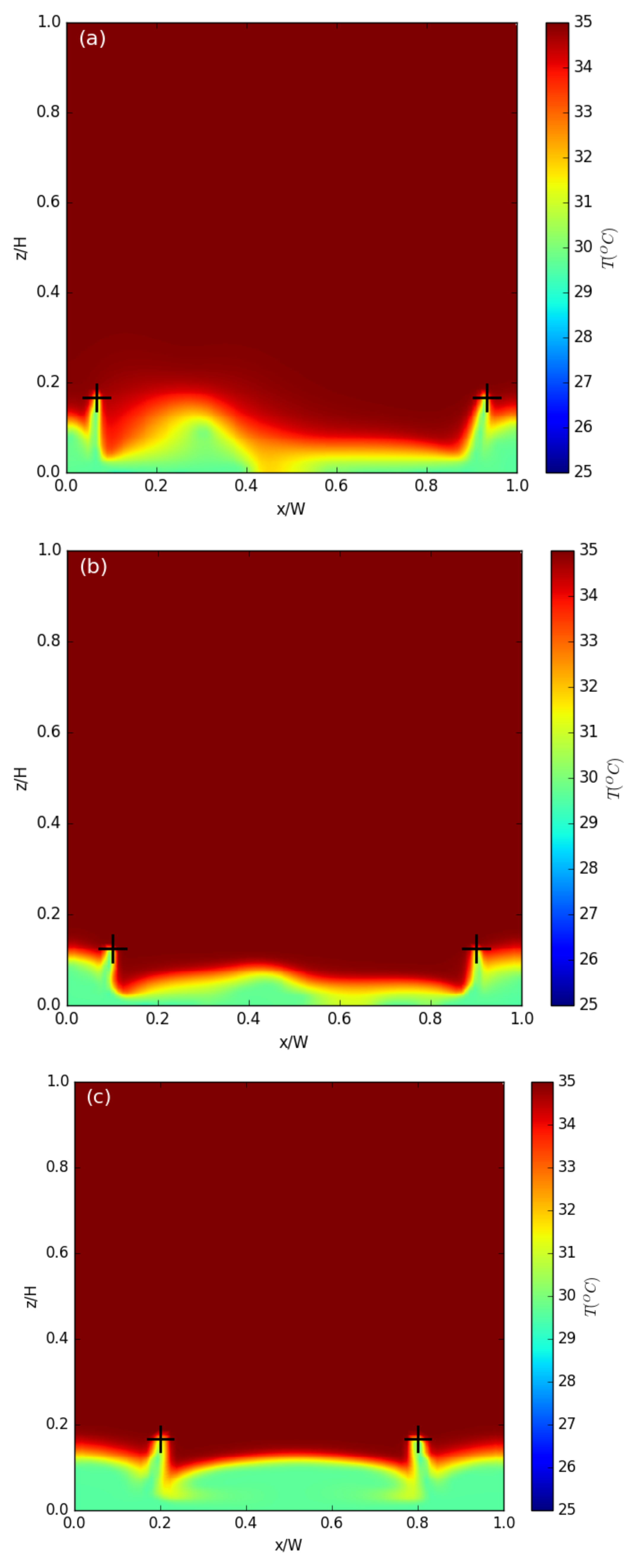
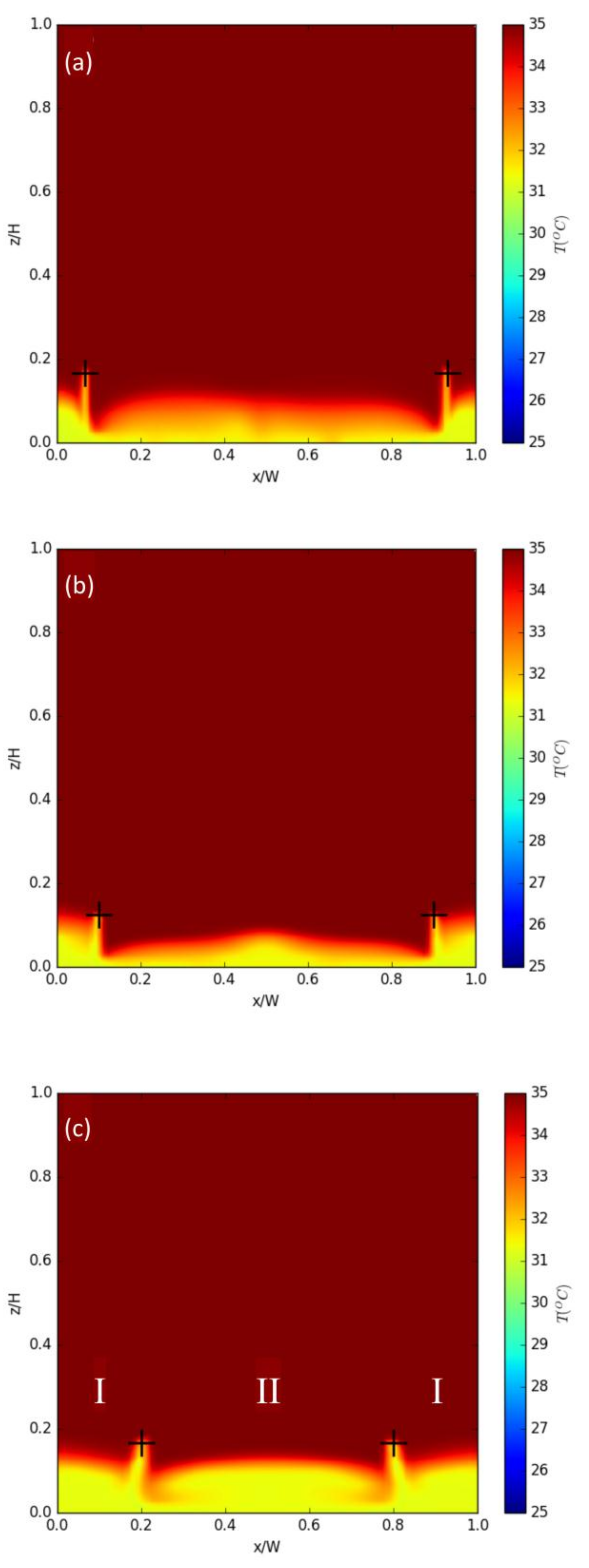
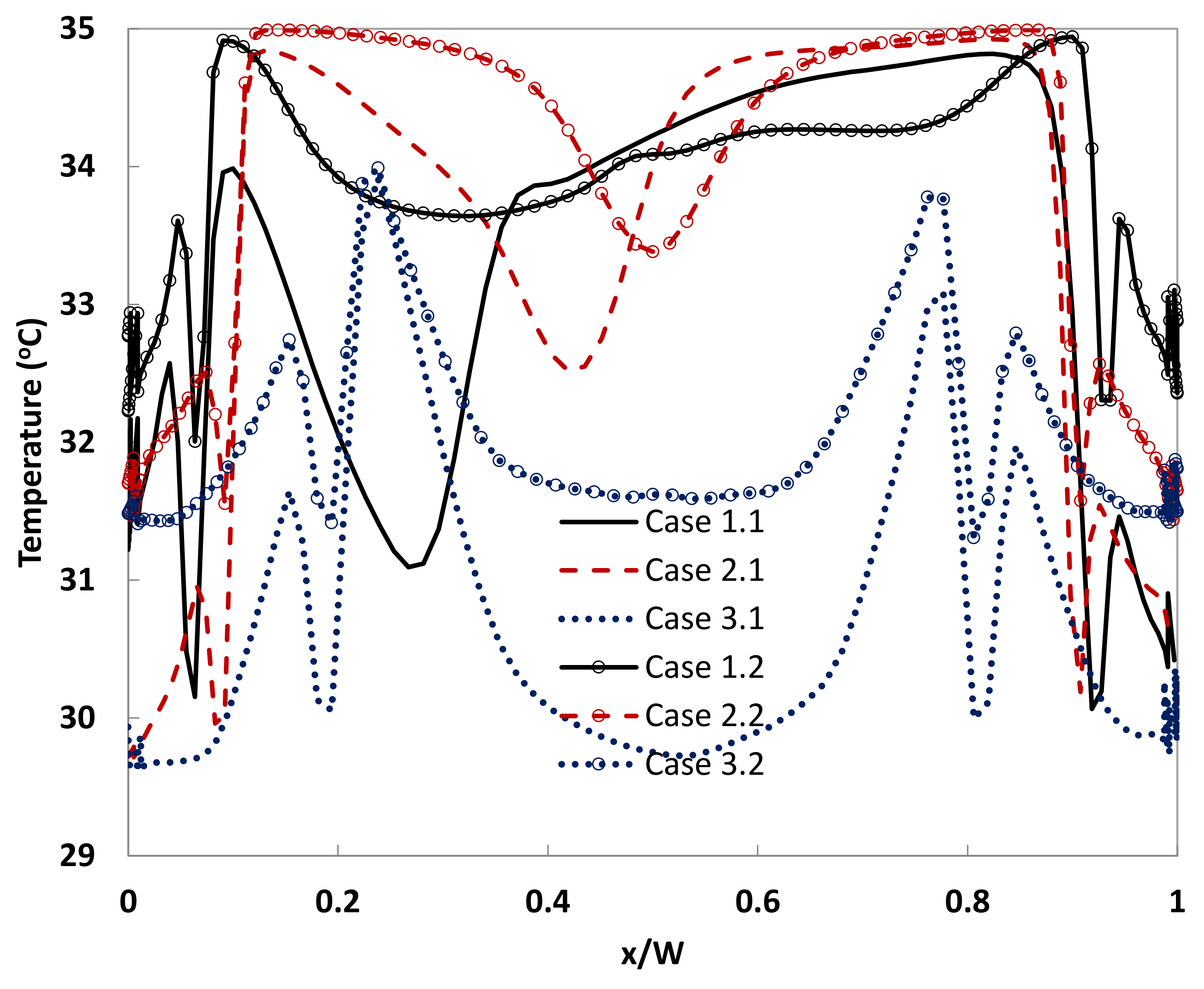

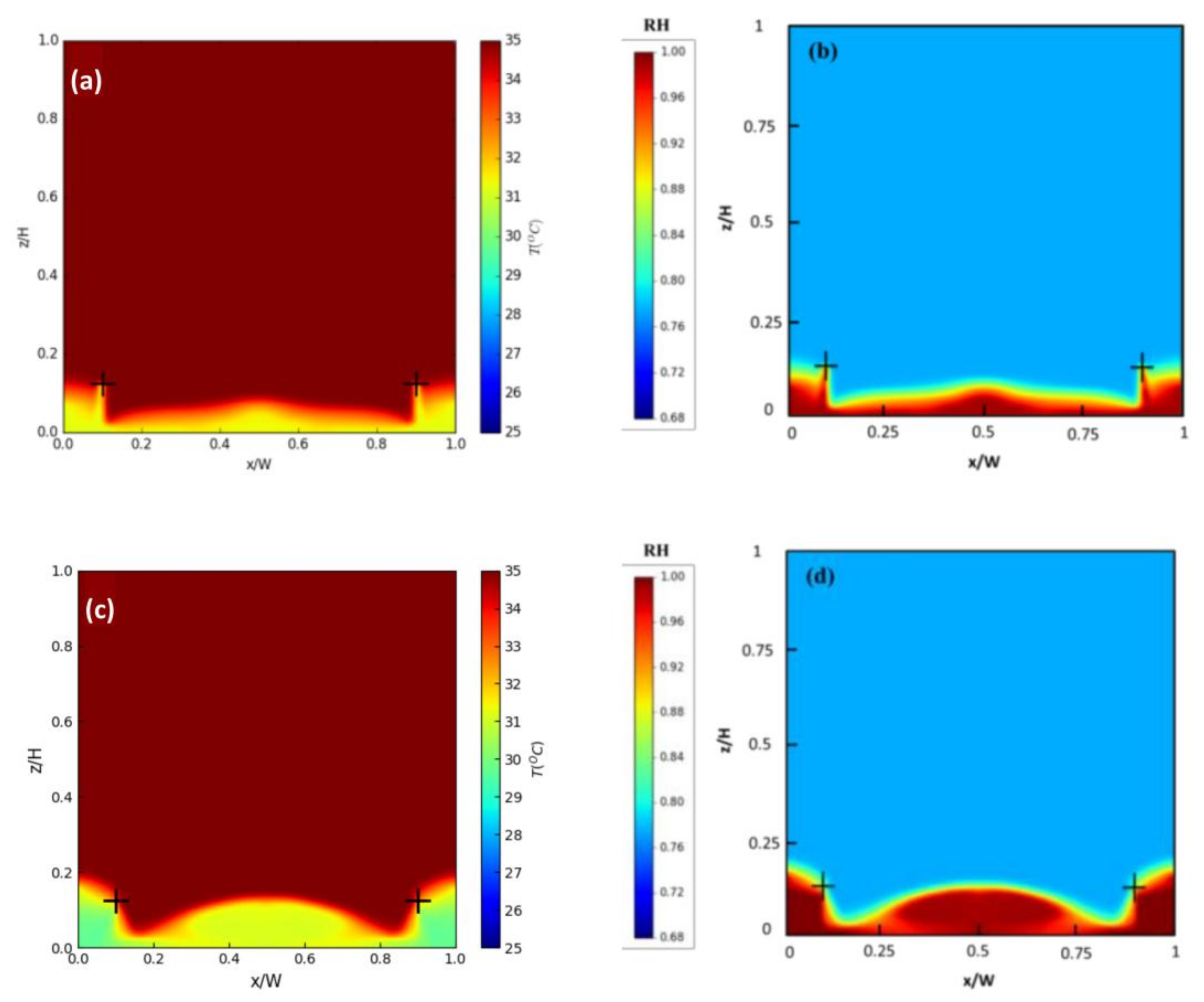
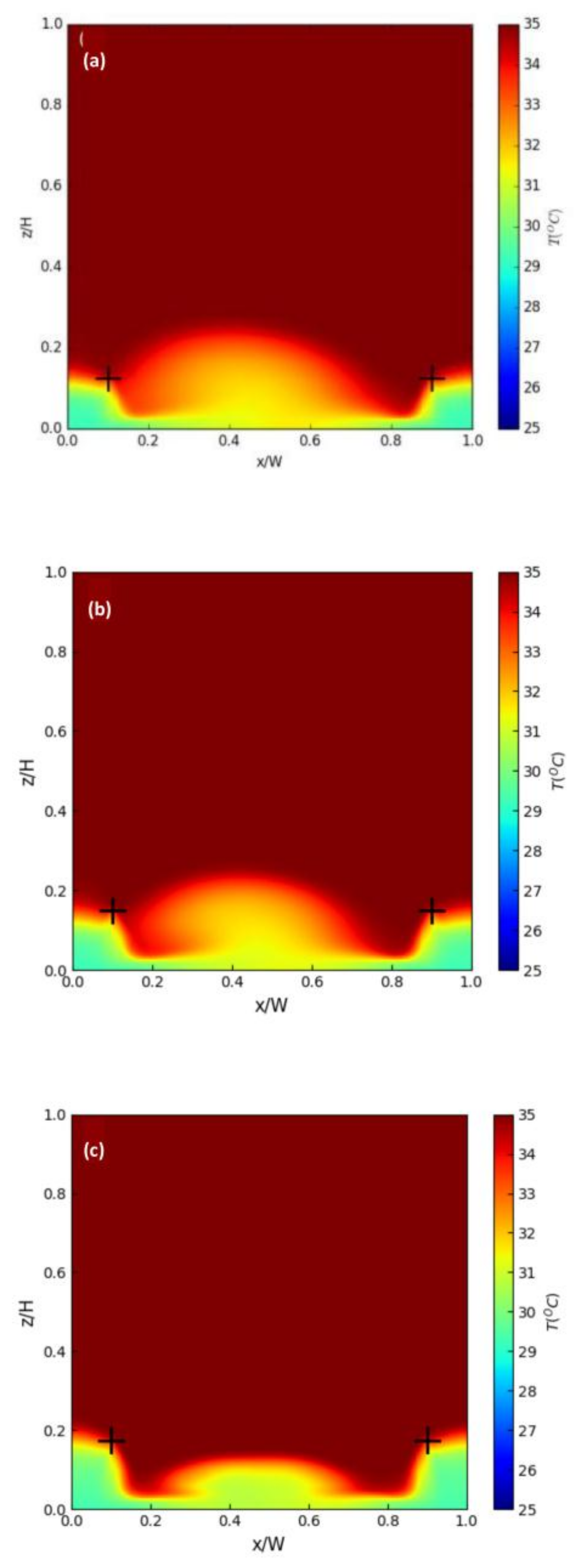
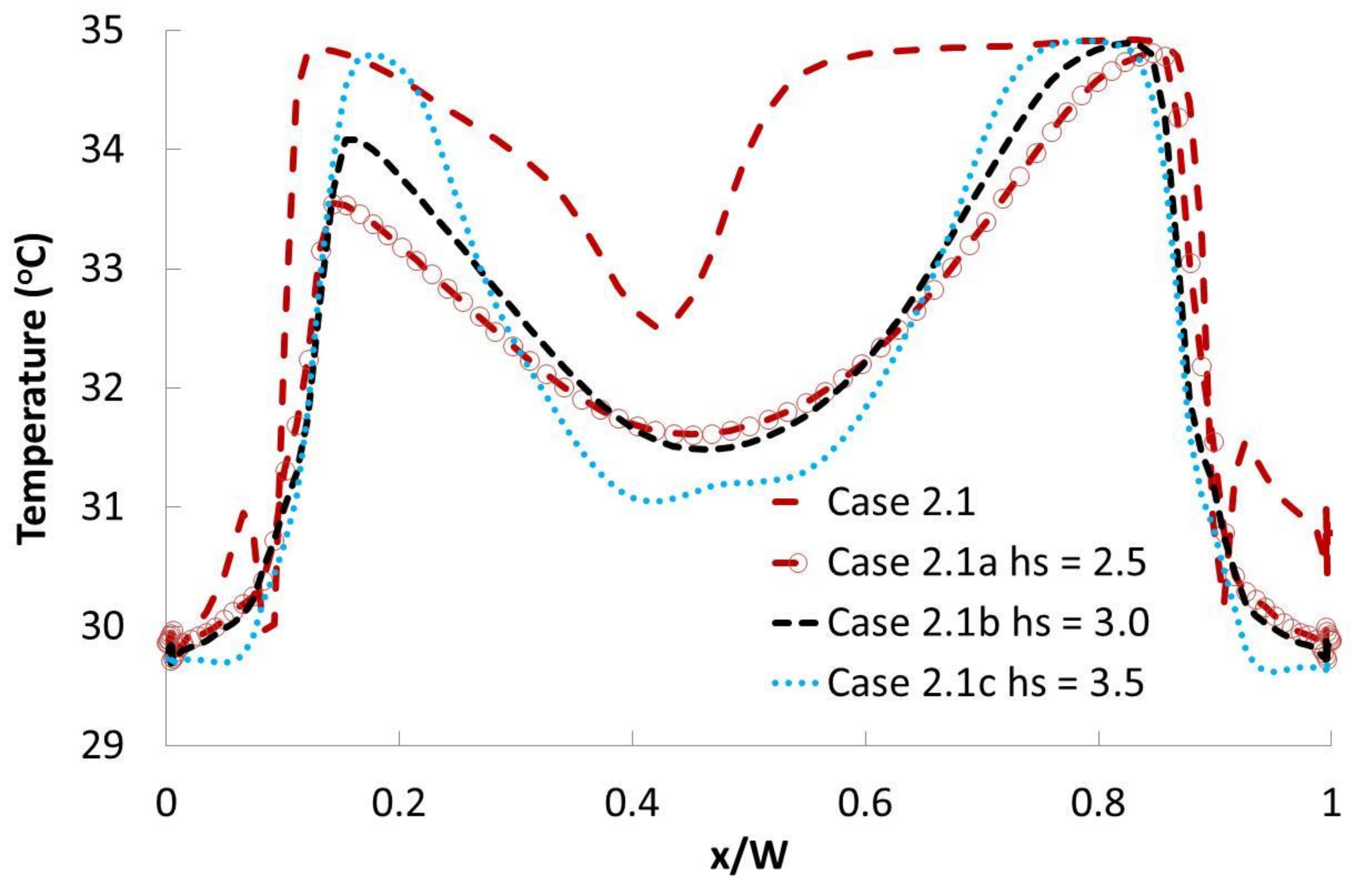
| Roughness of No-Slip Boundary | Time Step Size (sec) | Characteristics of the Spray Nozzle | |||||
|---|---|---|---|---|---|---|---|
| ks | Cs | Continuous Phase | Particle Phase | α/2 | Points of Injection | Radius | Tw |
| 1.5 | 0.5 | 0.05 | 0.001 | 20° | 15 | 2 mm | 25 °C |
| Group | Case | H/W | RH (%) | hs (m) | Vw (m/s) | (kg/s) | (μm) | Dmin (μm) | Dmax (μm) |
|---|---|---|---|---|---|---|---|---|---|
| # 1 (different H/W and RH) | 1.1 | 1 | 70 | 2.5 | −15 | 0.01 | 20 | 10 | 60 |
| 2.1 | 2 | 70 | 2.5 | −15 | 0.01 | 20 | 10 | 60 | |
| 3.1 | 3 | 70 | 2.5 | −15 | 0.01 | 20 | 10 | 60 | |
| 1.2 | 1 | 80 | 2.5 | −15 | 0.01 | 20 | 10 | 60 | |
| 2.2 | 2 | 80 | 2.5 | −15 | 0.01 | 20 | 10 | 60 | |
| 3.2 | 3 | 80 | 2.5 | −15 | 0.01 | 20 | 10 | 60 | |
| # 2 (different RH and ) | 2.1 | 2 | 70 | 2.5 | −15 | 0.01 | 20 | 10 | 60 |
| 2.1a | 2 | 70 | 2.5 | −22 | 0.2 | 369 | 74 | 518 | |
| 2.2 | 2 | 80 | 2.5 | −15 | 0.01 | 20 | 10 | 60 | |
| 2.2a | 2 | 80 | 2.5 | −22 | 0.2 | 369 | 74 | 518 | |
| # 3 (different hs) | 2.1a | 2 | 70 | 2.5 | −22 | 0.2 | 369 | 74 | 518 |
| 2.1b | 2 | 70 | 3 | −22 | 0.2 | 369 | 74 | 518 | |
| 2.1c | 2 | 70 | 3.5 | −22 | 0.2 | 369 | 74 | 518 |
| H/W = 1 | Linear Regression | R2 | RMSE |
| Baik and Kim (1999) | y = 0.794 x − 0.0153 | 0.9645 | 1.06 |
| This study | y = 1.126 x − 0.0068 | 0.9524 | 1.51 |
| H/W = 2 | Linear Regression | R2 | RMSE |
| Baik and Kim (1999) | y = 0.765 x − 0.0024 | 0.7678 | 0.55 |
| This study | y = 0.860 x + 0.0023 | 0.6699 | 0.66 |
| H/W = 1 | Linear Regression | R2 | RMSE |
| Baik and Kim (1999) | y = 1.3693 x − 0.0574 | 0.6066 | 0.1389 |
| This study | y = 0.7189 x − 0.0091 | 0.8866 | 0.0323 |
| H/W = 2 | Linear Regression | R2 | RMSE |
| Baik and Kim (1999) | y = 1.1545 x − 0.0067 | 0.3526 | 0.1801 |
| This study | y = 0.4125 x + 0.0002 | 0.5876 | 0.0400 |
| Humidity | RH = 70% | RH = 80% | dT | |||
|---|---|---|---|---|---|---|
| Region | I | II | I | II | I | II |
| H/W = 1 | 31.19 °C (Case 1.1) | 33.75 °C | 32.92 °C (Case 1.2) | 34.16 °C | 1.73 °C | 0.41 °C |
| H/W = 2 | 30.63 °C (Case 2.1) | 34.30 °C | 32.06 °C (Case 2.2) | 34.61 °C | 1.43 °C | 0.31 °C |
| H/W = 3 | 30.41 °C (Case 3.1) | 30.91 °C | 31.86 °C (Case 3.2) | 32.26 °C | 1.45 °C | 1.35 °C |
| Ta (°C) | RH = 80% | RH = 70% | RH = 60% |
|---|---|---|---|
| 28 | 25.22834 | 23.72297 | 22.12597 |
| 29 | 26.17136 | 24.63169 | 22.99545 |
| 30 | 27.1149 | 25.54114 | 23.86579 |
| 31 | 28.05896 | 26.45136 | 24.73706 |
| 32 | 29.00361 | 27.36237 | 25.6093 |
| 33 | 29.94881 | 28.2742 | 26.48255 |
| 34 | 30.89454 | 29.18683 | 27.35681 |
| 35 | 31.84087 | 30.10032 | 28.23216 |
| 36 | 32.78777 | 31.01464 | 29.10856 |
| 37 | 33.73522 | 31.92981 | 29.98605 |
| 38 | 34.6832 | 32.8458 | 30.8647 |
| 39 | 35.63174 | 33.76264 | 31.7444 |
| 40 | 36.58084 | 34.68032 | 32.62526 |
© 2018 by the authors. Licensee MDPI, Basel, Switzerland. This article is an open access article distributed under the terms and conditions of the Creative Commons Attribution (CC BY) license (http://creativecommons.org/licenses/by/4.0/).
Share and Cite
Lee, Y.-C.; Chang, T.-J.; Hsieh, C.-I. A Numerical Study of the Temperature Reduction by Water Spray Systems within Urban Street Canyons. Sustainability 2018, 10, 1190. https://doi.org/10.3390/su10041190
Lee Y-C, Chang T-J, Hsieh C-I. A Numerical Study of the Temperature Reduction by Water Spray Systems within Urban Street Canyons. Sustainability. 2018; 10(4):1190. https://doi.org/10.3390/su10041190
Chicago/Turabian StyleLee, Ying-Chen, Tsang-Jung Chang, and Cheng-I Hsieh. 2018. "A Numerical Study of the Temperature Reduction by Water Spray Systems within Urban Street Canyons" Sustainability 10, no. 4: 1190. https://doi.org/10.3390/su10041190





